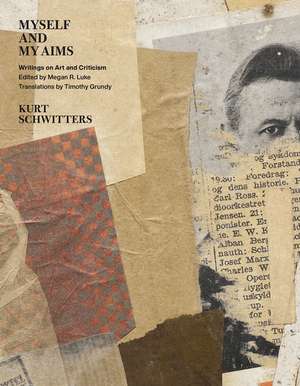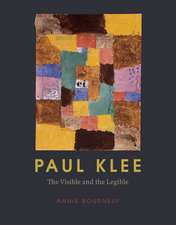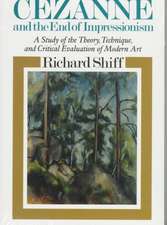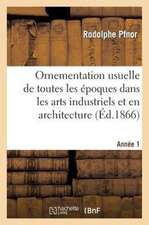Myself and My Aims: Writings on Art and Criticism
Autor Kurt Schwitters Editat de Megan R. Luke Traducere de Timothy Grundyen Limba Engleză Hardback – 10 mar 2021
As the first anthology in English of the critical and theoretical writings of this influential artist, Myself and My Aims makes the case for Schwitters as one of the most creative thinkers of his generation. Including material that has never before been published, this volume presents the full range of his prolific writing on the art and attitudes of his time, joining existing translations of his children’s stories, poetry, and fiction to give new readers unprecedented access to his literary imagination. With an accessible introduction by Megan R. Luke and elegant English translations by Timothy Grundy, this book will prove an exceptional resource for artists, scholars, and enthusiasts of his art.
Preț: 303.23 lei
Nou
Puncte Express: 455
Preț estimativ în valută:
58.03€ • 62.05$ • 48.38£
58.03€ • 62.05$ • 48.38£
Carte disponibilă
Livrare economică 27 martie-10 aprilie
Livrare express 12-18 martie pentru 71.25 lei
Preluare comenzi: 021 569.72.76
Specificații
ISBN-13: 9780226129396
ISBN-10: 022612939X
Pagini: 656
Ilustrații: 83 halftones
Dimensiuni: 178 x 229 x 51 mm
Greutate: 1.28 kg
Ediția:First Edition
Editura: University of Chicago Press
Colecția University of Chicago Press
ISBN-10: 022612939X
Pagini: 656
Ilustrații: 83 halftones
Dimensiuni: 178 x 229 x 51 mm
Greutate: 1.28 kg
Ediția:First Edition
Editura: University of Chicago Press
Colecția University of Chicago Press
Notă biografică
Kurt Schwitters (1887–1948) was a German artist known for his work in collage, assemblage, sculptural installation, performance, sound, and concrete poetry. Megan R. Luke is associate professor of Art History at the University of Southern California and author of Kurt Schwitters: Space, Image Exile. Timothy Grundy is an independent translator living in Los Angeles.
Cuprins
List of Illustrations
An Introduction to Merz-Thought
A Note to the Reader
An Introduction to Merz-Thought
A Note to the Reader
1 The Problem of Abstract Art. First Attempt (June–August 1910)
2 Problem of Pure Painting. 2nd Attempt. 1. Beginning (before December 1910)
3 Materials for My Work on the Problem of Pure Painting. 3rd Attempt (November 1910)
4 2nd Beginning to the Problem of Pure Painting. 2nd Attempt (December 1910–January 1911)
5 Abstract Painting. 1918. A. (February 1918)
6 Merz-Painting (July/November 1919)
7 A Solid Article: A Wienerization in Sturm (August 1919)
8 The Merz-Theater / To All the Theaters of the World (1919)
9 Artists’ Right to Self-Determination (1919)
10 Thou Me, I Thee, We Mine (and Sun Infinity Thin Out the Stars) (December 1919)
11 Nothing Kills Quicker Than Ridicule (February 1920)
12 Berliner Börsenkukukunst (February 1920)
13 Tran Number 7. General Amnesty for My Hannoverian Critics in the Style of Merz (April 1920)
14 What Art Is: A Guide for Great Critics (April 1920)
15 Statement (April 1920)
16 [I divide my poetry into three types . . .] (April 1920)
17 Hannover (June 1920)
18 Extension (June 1920)
19 Tran Number 11. German Popular Criticism, the Criticism of Reconstruction (August 1920)
20 Tran No. 12. Criticism as Artwork (September 1920)
21 Tran Number 13. The Private Scouring Cloth: Contribution to a Phenomenology of Critical Enjoyment (October 1920)
22 Tran No. 14. Dr. Frog Starves the Intellect (October 1920)
23 Tran Number 16. Life on Blind Feet (December 1920)
24 Kurt Schwitters (1920)
25 Tran Number 17. The Fettered Paul Madsack (December 1920)
26 MERZ (Written for the Ararat, 19 December 1920) (January 1921)
27 Tran No. 15. The Average Phenomenon with Clear Eyes (January 1921)
28 Why I Am Dissatisfied with Oil Painting (January 1921)
Translated from Hungarian by John Batki
29 Tran 18 (February 1921)30 Evening Reading (ca. February 1921)
31 My Views on the Value of Criticism (for the Ararat) (May 1921)
32 Cleanliness (for People Who Don’t Know It Yet) (May 1921)
33 Tran 19 (August 1921)
34 Castle and Cathedral with Courtyard Fountain (1922)
35 Tran 21. Speech at the Grave of Leo Rein (in the Berliner Börsenzeitung 547 on 27 November 1921) (January 1922)
36 Tragedy. Tran No. 22, against Dr. Weygandt, PhD and MD (May 1922)
37 i (A Manifesto) (May 1922)
38 Tran No. 26 (1922)
39 Tran 23 (September 1922)
40 Introduction to Tran No. 30: Auguste Bolte (1923)
41 The Self-Overcoming of Dada (January 1923)
Translated from Dutch by Michael White
42 [Introduction to Merz 1. Holland Dada] (January 1923)43 Dadaism in Holland (January 1923)
44 [Editorial note to Vilmos Huszár, Mechanische Dansfiguur] (January 1923)
45 Style (ca. January–April 1923)
46 i (April 1923)
47 WAR (April 1923)
48 War (April 1923)
49 Manifesto Proletarian Art (April 1923)
50 From the World: “MERZ” (April–June 1923)
51 Banalities (3) (July 1923)
52 dada complet. 1 (July 1923)
53 Banalities (4) / [Tristan Tzara] (July 1923)
54 DADA NEWS (July 1923)
55 WATCH YOUR STEP! (October 1923)
56 Merz (1924)
57 i (January 1924)
58 DADA COMPLET No. 2. / TRAN 50 (January 1924)
59 Dadaists (January 1924)
60 [Advertisement for Merz 8/9. Nasci] (January 1924)
61 Tran 35. Dada Is a Hypothesis (March 1924)
62 Rigorous Poetry (June 1924)
63 Dadaism (1924)
Translated from Polish by Kamila Kuc
64 National Feeling (August 1924)65 The Westheim Threat, Again (December 1924)
66 National Art (1925)
67 [What Is Madness?] (ca. mid-1920s)
68 Theses on Typography (1925)
69 [The Standard Merz Stage] (1925)
70 STANDARD MERZ STAGE (July 1925)
71 Religion or Socialism (July 1925)
72 STANDARD MERZ STAGE (Some Practical Suggestions.) (July 1925)
73 The ABC of the Standard Merz Stage (July 1925)
74 Language (November 1925)
75 Standard Stage by Kurt Schwitters (December 1925)
76 Gut Garkau (ca. late 1925/early 1926)
77 FANTASTIC THOUGHTS (ca. 1926)
78 Art and the Times (March 1926)
79 The New Architecture in Germany (March 1926)
80 Life’s Path (May 1926)
81 Facts from My Life (June 1926)
82 Rhythm in the Work of Art (October 1926)
83 Merz-Book (October 1926)
84 Standard Stage (October 1926)
85 My Merz and My Monster Merz: Model Marketplace at Sturm (October 1926)
86 Call It Coincidence (ca. mid-1920s)
87 The Artist and His Titles (1926)
88 Merz 20. Kurt Schwitters Catalogue (1927)
89 [Ella Bergmann-Michel] (March 1927)
90 [Letter to Wassily Kandinsky] (April 1927)
91 Elementary Knowledge in Painting (ca. 1927)
92 Style or Form-Creation (1927)
93 typography and orthography: lowercase (ca. 1927)
94 Sensation (July 1927)
95 Front against Fronta: Afterword to the Foreword of Fronta (July–August 1927)
96 Proposals for a Systematic Typeface (August–September 1927)
97 Sense of Duty (September 1927)
98 Stuttgart, The Home—Werkbund Exhibition (October 1927)
99 My Sonata in Ur-Sounds (November 1927)
100 Kitsch and Dilettantism (December 1927)
101 Good or Bad Fortune (December 1927)
102 On Greek Temples (April 1928)
103 Appearance (ca. spring 1928)
104 Third Prague Letter (May 1928)
105 The New Architecture in Celle: The Architect Otto Haesler (August 1928)
106 Form-Creating Typography (September 1928)
107 Modern Advertising (October 1928)
108 Werkbund Congress in Munich, 1928 (November 1928)
109 Stories That Have Run Their Course (November 1928)
110 Revue by Three Reviewed (December 1928)
111 [Review of Hans Hildebrandt, Woman as Artist] (December 1928)
112 Hannover and the Abstract Room by Lissitzky (April 1929)
113 About Me by Myself (May 1929)
Originally published in English, translator unknown
114 A Layman’s Judgment of New Architecture (June 1929)115 The Style of the Age and the Dammerstock Housing Estate (September 1929)
116 Facts from My Life (December 1929)
117 [The art of today is a strange thing . . .] (March 1930)
Translated from French by Eva Morawietz
118 the ring neue werbegestalter (1930)119 Advertising Design (1930)
120 Form-Creation in Typography (February and April 1930)
121 Painting (ca. late 1920s/early 1930s)
122 On the Uniform Design of Print Materials (1930)
123 Kurt Schwitters (1930)
124 [The Big E is finished . . .] (ca. 1930–33)
125 Myself and My Aims (1931)
126 [We know the Doesburg of “Stijl” . . .] (June 1931/January 1932)
127 merz-paintings (1932)
Translated from French by Eva Morawietz
128 [Statement about the Merzbau] (1933)Translated from French by Eva Morawietz
129 [Excerpts from letters to Susanna Freudenthal-Lutter about the Merzbau] (February and March 1935)130 [Excerpt from a letter to Susanna Freudenthal-Lutter about landscape painting] (July 1935)
131 The Work of Art (ca. 1937–40)
132 Impressionism/Expressionism (ca. 1937–40)
133 The Tin Palm Tree (July 1937)
134 [I once saw a famous singer in a film . . .] (December 1937)
135 [Anyone who wants to write about people . . .] (December 1937)
136 Sheet 1. For My New Studio (April 1938)
137 Sheet 2 (April 1938)
138 Merz (April 1938)
139 [I first saw the light of the world in the year 1887 . . .] (June 1938)
140 [Once we realize that, basically, everything is futile . . .] (after 16 December 1939)
141 Truth (ca. 1930s)
142 Art (January 1940)
143 Mixing of Artistic Genres (ca. 1940)
144 Theory in Painting (January 1940)
145 Painting (Pure Painting) (October 1940)
146 [The Portrait] (October 1940)
147 European Art of the 20th Century (between 17 July 1940 and 22 November 1941)
148 [Statement declining membership in the Freier Deutscher Kulturbund] (after November 1941)
149 Abstract Art (after November 1941)
Original in English
150 Material and Aims (after November 1941)Original in English
151 [Kurt Schwitters] (after November 1941)Original in English
152 The Origin of Merz (after November 1941)153 [Kurt Schwitters] (after November 1941)
Original in English
154 [Renaissance] (after 30 October 1945)155 [Answers to a questionnaire for La savoir vivre] (1946)
Translated from French by Eva Morawietz
156 Key for Reading Sound Poems (September 1946)Original in English
157 My Art and My Life (ca. 1946–47)Original in English
Acknowledgments
Notes
Index
Recenzii
"Schwitters was a one-person Gesamtkunstwerk, who both concentrated and dispersed the old Wagnerian ideal. On the one hand, his practice was private, even domestic: his chief laboratory was his home in Hanover, which was gradually consumed by the first obsessive construction to be called ‘Merzbau’, a 3-D assemblage that eventually took up eight rooms. On the other hand, his activity involved multiple, often manic collaborations, the range of which is evident in the edition of his writings, expertly selected by Megan Luke and translated by Timothy Grundy."
"The collages Kurt Schwitters made may be instantly recognisable but less well known is his writing, from artistic credos to children’s stories—collected in an anthology in English for the first time."
"Kurt Schwitters (1887-1948) is a well-known name in the area of early 20th-century collage, though it must be admitted that his contributions to Dada art and its development are somewhat overshadowed by Marcel Duchamp, Tristan Tzara, Man Ray, and Francis Picabia. This anthology of his compelling writings goes a long way toward encouraging a reexamination of the German artist’s contributions to the inroads and sea-changes in art-making."
"The first anthology in English of the critical and theoretical writings of the influential artist best known for his Merz assemblages, demonstrating the range of his creative thinking."
“This indispensable collection follows Schwitters’ swiftly changing thought on a diverse range of subjects from architecture and painting to graphic art and poetry. In each case Schwitters delivers his canny diagnosis with rigor, humor, and unflinching belligerence. No figure was able to reconcile Dadaist nihilism with constructivist optimism quite like Schwitters, and his striking insights about the hollow metaphysics of consumer society will not fail to resonate with anyone torn between the positions of critique and complicity today.”





